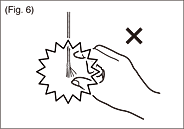Precautions
Precautions when Using and Installing the Hangers
- Periodically make sure that the wire is free of damage. If the wire is frequently bent or twisted, the strands of the wire might break. (Fig. 1)
- If the wire comes into contact with hanging articles or building elements such as walls or pillars, it may become damaged or lose strength after many years of use. Take steps to stop the wire from directly contacting wall surfaces, hanging artworks, etc.
- Before hanging a load, confirm that the wire is firmly inserted into the components. (Fig. 2)
- To prevent accidents, hanging work should be always performed by two or more persons. (Fig. 3)

Precautions when Using and Installing Hangers
|
 |
Precautions when Using and Installing the Hanger Hooks
- If the hanger hook button ceases to push in smoothly after many years of use, accumulated dust or rust might be interfering with the pushbutton mechanism. To ensure full safety, replacement with a new hanger hook is recommended. (Fig. 3)
- Do not let children play freely around these products. If a hook or wire is yanked or rocked deliberately, it could damage the hanging mechanism and increase the risk of falling artwork. (Fig. 4)
- These products are designed for hanging artworks or other articles for display. Never let children dangle themselves or pets with the hooks or cords, even if the applied weight is within the allowable load. (Fig. 5)
- Wire strands at the tips of frayed wire may pierce fingertips or other body parts. Pay attention when handling to avoid unexpected injury. If the wire is frayed, stop using the hanger and replace it. (Fig. 6)




